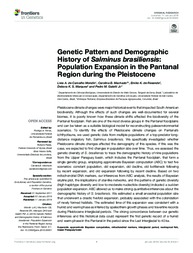Genetic pattern and demographic history of Salminus brasiliensis: population expansion in the Pantanal Region during the Pleistocene
Genetic pattern and demographic history of Salminus brasiliensis: population expansion in the Pantanal Region during the Pleistocene
Autoria: MONDIN, L. A. de C.; MACHADO, C. B.; RESENDE, E. K. de; MARQUES, D. K. S.; GALETTI JUNIOR, P. M.
Resumo: Pleistocene climate changes were major historical events that impacted South American biodiversity. Although the effects of such changes are well-documented for several biomes, it is poorly known how these climate shifts affected the biodiversity of the Pantanal floodplain. Fish are one of the most diverse groups in the Pantanal floodplains and can be taken as a suitable biological model for reconstructing paleoenvironmental scenarios. To identify the effects of Pleistocene climate changes on Pantanal?s ichthyofauna, we used genetic data from multiple populations of a top-predator longdistance migratory fish, Salminus brasiliensis. We specifically investigated whether Pleistocene climate changes affected the demography of this species. If this was the case, we expected to find changes in population size over time. Thus, we assessed the genetic diversity of S. brasiliensis to trace the demographic history of nine populations from the Upper Paraguay basin, which includes the Pantanal floodplain, that form a single genetic group, employing approximate Bayesian computation (ABC) to test five scenarios: constant population, old expansion, old decline, old bottleneck following by recent expansion, and old expansion following by recent decline. Based on two mitochondrial DNA markers, our inferences from ABC analysis, the results of Bayesian skyline plot, the implications of star-like networks, and the patterns of genetic diversity (high haplotype diversity and low-to-moderate nucleotide diversity) indicated a sudden population expansion. ABC allowed us to make strong quantitative inferences about the demographic history of S. brasiliensis. We estimated a small ancestral population size that underwent a drastic fivefold expansion, probably associated with the colonization of newly formed habitats. The estimated time of this expansion was consistent with a humid and warm phase as inferred by speleothem growth phases and travertine records during Pleistocene interglacial periods. The strong concordance between our genetic inferences and this historical data could represent the first genetic record of a humid and warm phase in the Pantanal in the period since the Last Interglacial to 40 ka.
Ano de publicação: 2018
Tipo de publicação: Artigo de periódico
Unidade: Embrapa Pantanal
Palavras-chave: Dourado, Fish, Peixe, Salminus brasiliensis
Observações
1 - Por padrão são exibidas publicações dos últimos 20 anos. Para encontrar publicações mais antigas, configure o filtro ano de publicação, colocando o ano a partir do qual você deseja encontrar publicações. O filtro está na coluna da esquerda na busca acima.
2 - Para ler algumas publicações da Embrapa (apenas as que estão em formato ePub), é necessário ter, no celular ou computador, um desses softwares gratuitos. Sistemas Android: Google Play Livros; IOS: iBooks; Windows e Linux: software Calibre.
Acesse outras publicações
Acesse a Base de Dados da Pesquisa Agropecuária (BDPA) para consultar o acervo completo das bibliotecas da Embrapa.

